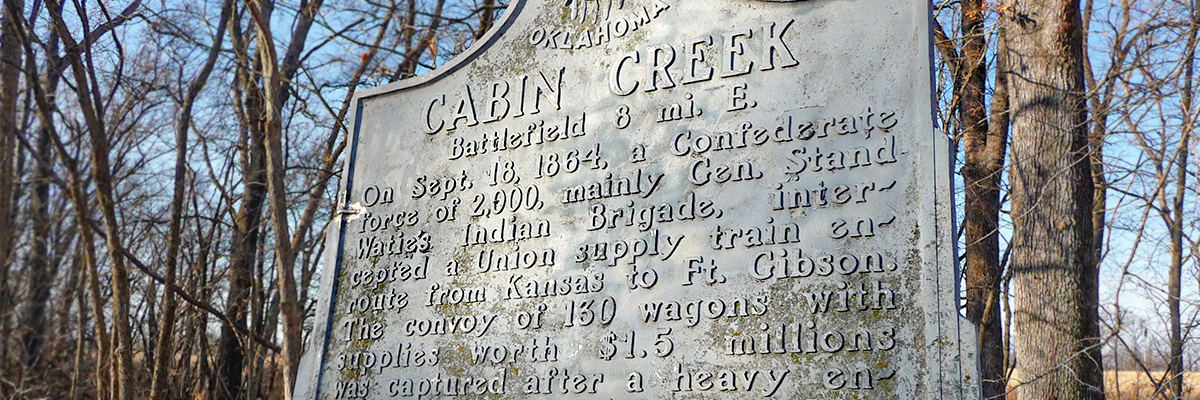
Cabin Creek Battlefield
Cabin Creek Battlefield
442370 E 367 Road
Big Cabin, OK 74332
cabincreek@history.ok.gov
Director: David Fowler
Directions: Take I-44 (Will Rogers Turnpike) to Big Cabin exit. Take Highway 69 south to Highway 28 east to Pensacola. Take road 4400 to road 350—turn left. The battlefield site will be on the left.
Battlefield Hours
Open daily from 8 a.m. to dusk
Free Admission

Cabin Creek Battlefield was the site of two key engagements between Union and Confederate forces in Indian Territory during the Civil War. The battlefield is located along the Texas Road, a historic trail from Kansas to Texas, near the ford that crosses the creek. The road was used by American Indians, explorers, the US Army, pioneer immigrants, trail herds, and traders. The land around the crossing was occupied by the residence and ranch buildings of prominent Cherokee Joseph Lynch “Greenbriar Joe” Martin.
The Texas Trail was the conduit for military supplies moving south from Fort Scott, Kansas, to Fort Gibson, Indian Territory, during the war. Several minor skirmishes occurred at the Cabin Creek crossing area. The first was a skirmish on May 8, 1863, near Martin’s house. Little is known about this event. The First Battle of Cabin Creek, July 1–2, 1863, and was an attempt by Confederate forces under Colonel Stand Watie to capture a Federal supply wagon train. The Federal troops were commanded by Colonel James Williams, whose force consisted of the Third Indian Home Guard, 1st Kansas Colored Volunteer Infantry, and units from Colorado, Kansas, and Wisconsin. Watie’s troops contested the ford but were driven off by artillery fire followed by infantry and cavalry charges. On July 5, 1863, a skirmish occurred involving the Kansas 2nd Battery, Light Artillery. On July 20, the First Indian Home Guard skirmished with Confederates.
The Second Battle of Cabin Creek on September 19, 1864, was another attempt to capture Federal supplies en route to Fort Gibson. Brigadier Generals Richard Gano and Stand Watie made a night attack on the Federal encampment that routed Union defenders. The supplies and 130 wagons were captured. This was the last major engagement in Indian Territory during the Civil War.
Visit The Encyclopedia of Oklahoma History and Culture to learn more about the battles and history of Cabin Creek.
Preservation efforts began in 1961 when the Vinita Chapter of the United Daughters of the Confederacy purchased a ten-acre parcel in the core battlefield area. Later that year, the acreage was donated to the Oklahoma Historical Society (OHS). A circle drive loop provides access to monuments and signage telling the story of the site.
In 2012 the Civil War Preservation Trust, the Friends of Cabin Creek, and the OHS secured 86.5 acres through private fundraising and a Battlefield Protection grant through the National Park Service. The Oklahoma Historical Society administers this 96.5-acre historic site.





